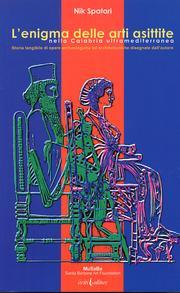The AGON academic Journal of Italy (Università degli Studi di Messina; chief editors: Professor Massimo Lagana & Professor Salvatore Albanese) has published an article by Kaveh Farrokh which examines historical ties between Greco-Roman civilization and ancient Iran. The article can be downloaded in full from Academia.edu below:
The article in AGON (Rivista Internazionale di Studi Culturali) begins as thus:
Apharban, the Persian ambassador representing Sassanian king Narses (r. 293-302 CE) during negotiations with the Roman general Galerius1 in the aftermath of his victory over Sassanian forces in 291-293 CE stated the following to his Roman hosts:
“It is clear to all mankind that the Roman and Persian empires are like two lights, and like (two) eyes, the brilliance of one should make the other more beautiful and not continuously rage for their mutual destruction” [Peter the Patrician, fragment 13; translation made by Canepa (2010, p. 133)].
The article examines the process and history of the long-standing relations between the Greco-Roman and ancient Iranian civilizations, notably during the during the Achaemenid (559 BCE-333 BCE), Parthian (250 BCE-224 CE) and Sassanian dynasties (224-651 CE). Works of researchers such as Professor Nik Spatari, whose works examining East-West ties in the context of ancient Calabria in southern Italy are also cited:
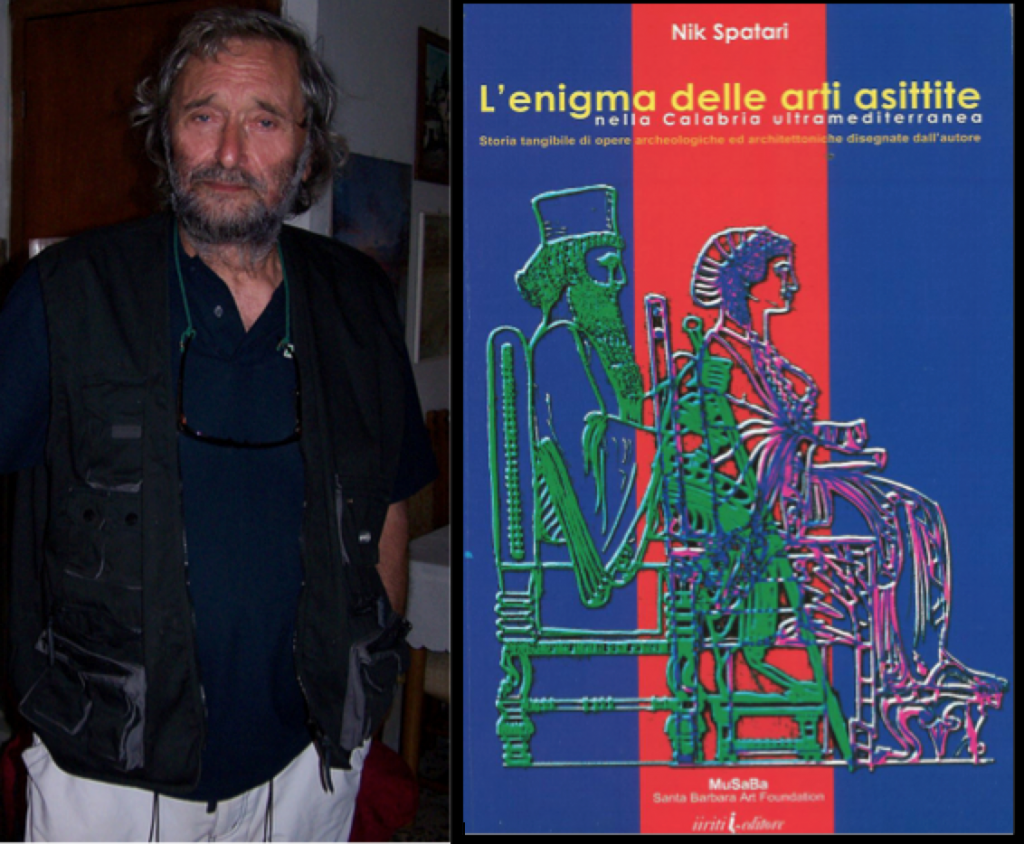
Professor Nik Sparati (Left) and his book “L’ enigma delle arti Asittite della Calabria Ultra-Mediterranea” (Published by: MuSaBa: Santa Barbera Art Foundation & Iiriti Editore, 2002). Note that the book jacket features the superimposed images of Darius the Great and Persephone (also known as Kore), the Mediterranean Goddess: Spatari has discovered Achaemenid-Persian artistic influences upon the Persephone (Kore) image. Among other ancient Iran-Italy ties, Spatari and his team have also discovered strong parallels between Sassanian architecture and the Basilica di Massenzio.
Architecture is one of the areas examined in detail from the time of the Achaemenids to the end of the Sassanian era. As noted by Professors Curatola and Scarcia a common theory postulates that:
“…domed spaces in Christian buildings in Europe derive from the Armenian model, which, in turn, comes from Sassanian Persia: This can be attributed to geographic proximity and also to the fact that for long periods Armenia was contained within Eranshahr. “ (Curatola & Scarcia, 2007, p. 92).
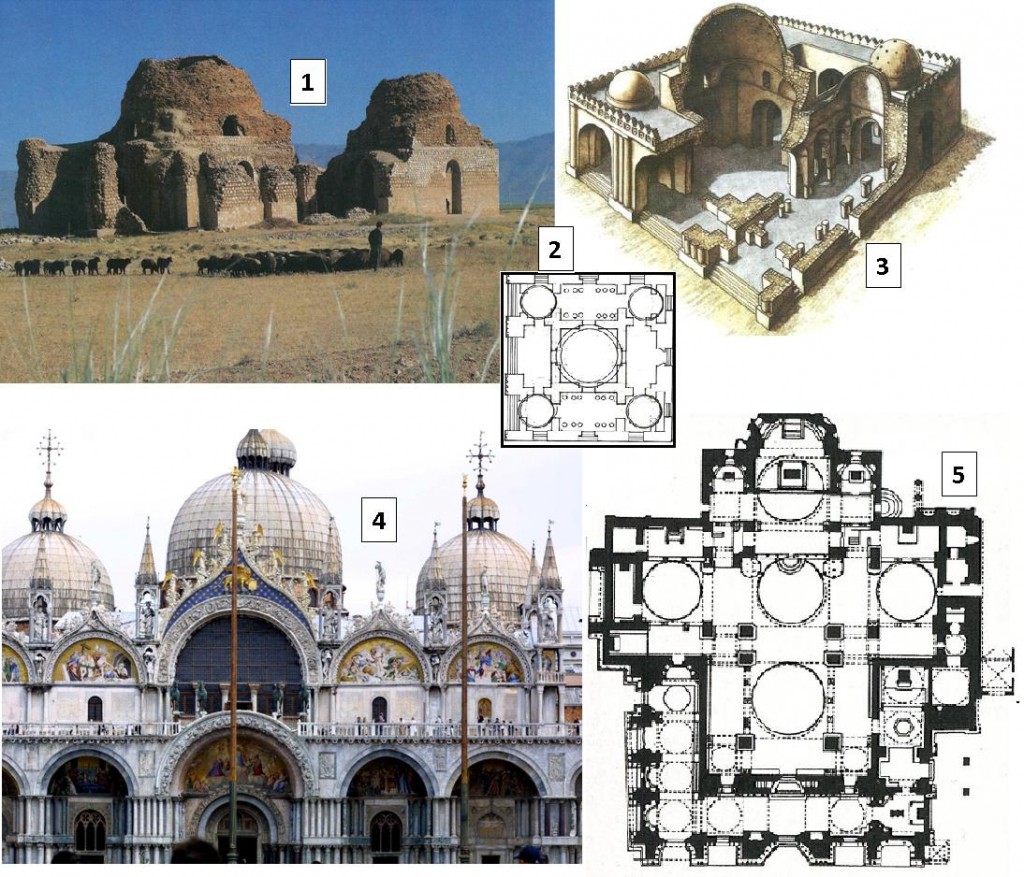
The Sarvestan palace: [1] floor plan of Sarvestan by Nik Spatari [2] reconstruction of Sarvestan by Oscar Reuther, “Sasanian Architecture,” in Survey of Persian Art, Figure 152). [3] the Basilica di S. Marco in Veneziana built in the time period of 1100-1300 AD [4] and floor plan of the Basilica di S. Marco (Pictures used in Kaveh Farrokh’’s lectures at the University of British Columbia’s Continuing Studies Division and Stanford University’s WAIS 2006 Critical World Problems Conference Presentations on July 30-31, 2006.
Sassanian Iran was to leave a profound legacy on Romano-Byzantine architecture during its tenure in 224-651 CE. As noted in the paper however, architectural influences from ancient Iran can be traced back to the earlier Parthian and Achaemenid eras.
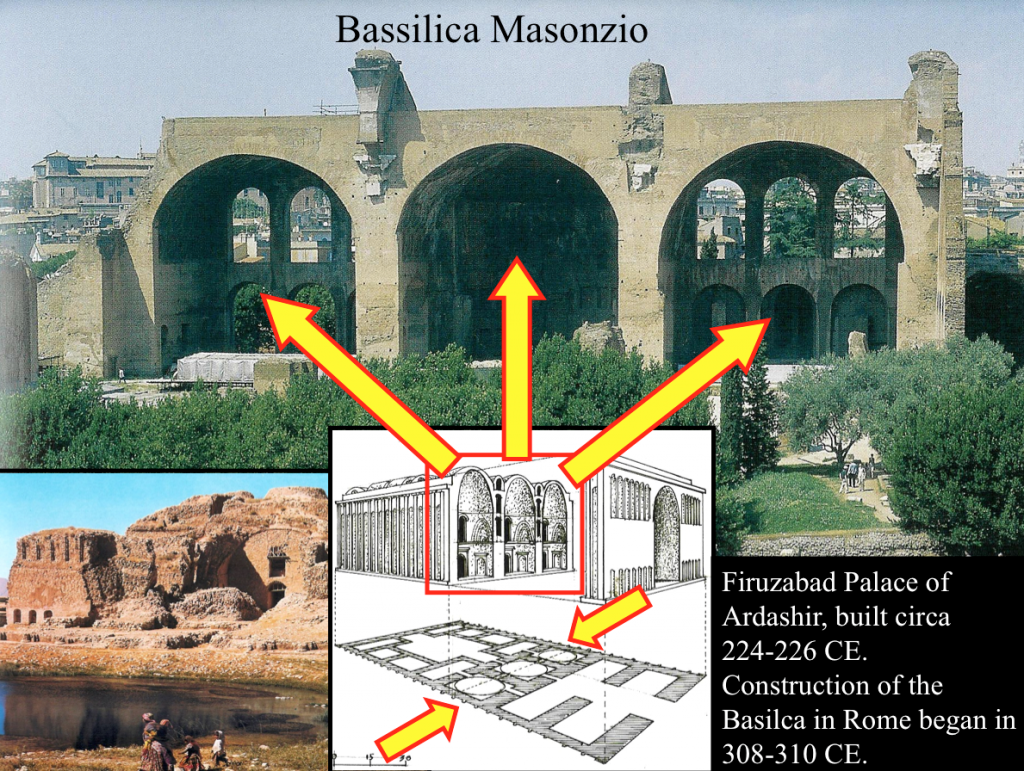
A lecture slide used in instruction forKaveh Farrokh’s lectures at the University of British Columbia’s Continuing Studies Division(this was also presented at Stanford University’s WAIS 2006 Critical World Problems Conference Presentations on July 30-31, 2006, theannual Tirgan event at Toronto (June, 2013)and atYerevan State University’s Iranian Studies Department (November, 2013) (Slide is Copyright of University of British Columbia and Kaveh Farrokh). The above slide discusses the parallels discovered by Professor Nik Spatari with respect to the “tri-chamber” design at Firuzabad and the Basilica di Massenzio. The floor plan of Ardashir’s palace and the “tri-chamber” (note yellow arrows) have been outlined by the Calabria research teams who noted of the parallels with the Basilica in Rome.
The ties of the Greco-Romans and ancient Iran are examined in a variety of other contexts besides architecture, notably the arts (Darius-Persephone motif, silverware, motifs such the Senmurv, etc.) and technology (communications, Qanat aqueducts, windmills, etc.).

An example of technology exchanges: an old water wheel in Tehran (Image: Farda News) [at Left]; reconstructed water wheel based on the ancient Persian model from Cordoba, Spain (Image:Graham Beards in Public Domain). The Greco-Roman and ancient Iranian civilizations often engaged in the exchange of technologies in antiquity. The Persian water wheel spread from ancient Iran to Rome (which introduced this technology into Europe) as well as China in antiquity (Kurz, 1985, p.563).
The culinary arts (transmission of cooking styles, exchange of nuts, fruits, etc. ) are also examined. The pistachio plant for example, was first located in the Khorasan and Soghd regions; these were first cultivated in West Khorasan and were unknown by other peoples until the Achaemenid era.
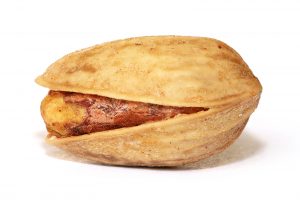
TheAchaemenidswere the first to commercially grow the pistachio in ancient Iran and export this to neighboring countries more than 2500 years ago (Image: Public Domain). By the Sassanian Era the pistachio was considered a delicatessen (mostly used in baking and in cookies). Pahlavi texts dating to theSassanian eramention the Gorgani pistachio as especially famous at the time. The Roman world not only adopted the pistachio (already known by Greco-Iranian contacts) and spread this to the European peoples.

